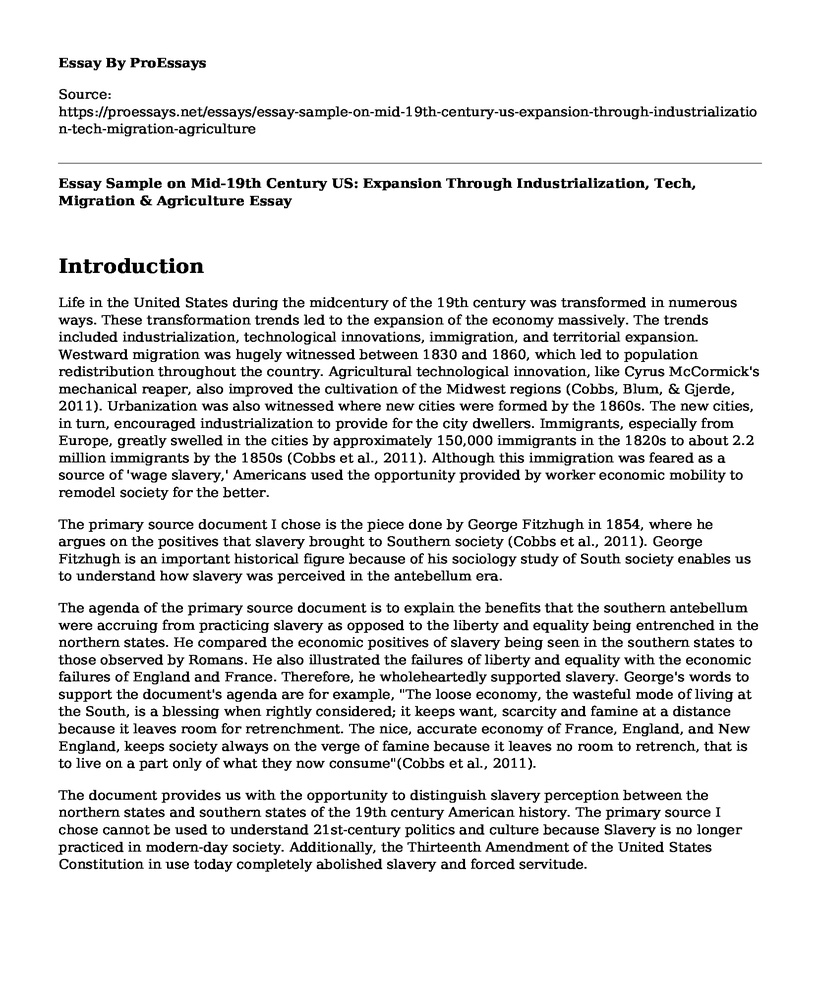Introduction
Life in the United States during the midcentury of the 19th century was transformed in numerous ways. These transformation trends led to the expansion of the economy massively. The trends included industrialization, technological innovations, immigration, and territorial expansion. Westward migration was hugely witnessed between 1830 and 1860, which led to population redistribution throughout the country. Agricultural technological innovation, like Cyrus McCormick's mechanical reaper, also improved the cultivation of the Midwest regions (Cobbs, Blum, & Gjerde, 2011). Urbanization was also witnessed where new cities were formed by the 1860s. The new cities, in turn, encouraged industrialization to provide for the city dwellers. Immigrants, especially from Europe, greatly swelled in the cities by approximately 150,000 immigrants in the 1820s to about 2.2 million immigrants by the 1850s (Cobbs et al., 2011). Although this immigration was feared as a source of 'wage slavery,' Americans used the opportunity provided by worker economic mobility to remodel society for the better.
The primary source document I chose is the piece done by George Fitzhugh in 1854, where he argues on the positives that slavery brought to Southern society (Cobbs et al., 2011). George Fitzhugh is an important historical figure because of his sociology study of South society enables us to understand how slavery was perceived in the antebellum era.
The agenda of the primary source document is to explain the benefits that the southern antebellum were accruing from practicing slavery as opposed to the liberty and equality being entrenched in the northern states. He compared the economic positives of slavery being seen in the southern states to those observed by Romans. He also illustrated the failures of liberty and equality with the economic failures of England and France. Therefore, he wholeheartedly supported slavery. George's words to support the document's agenda are for example, "The loose economy, the wasteful mode of living at the South, is a blessing when rightly considered; it keeps want, scarcity and famine at a distance because it leaves room for retrenchment. The nice, accurate economy of France, England, and New England, keeps society always on the verge of famine because it leaves no room to retrench, that is to live on a part only of what they now consume"(Cobbs et al., 2011).
The document provides us with the opportunity to distinguish slavery perception between the northern states and southern states of the 19th century American history. The primary source I chose cannot be used to understand 21st-century politics and culture because Slavery is no longer practiced in modern-day society. Additionally, the Thirteenth Amendment of the United States Constitution in use today completely abolished slavery and forced servitude.
References
Cobbs, E., Blum, E. J., & Gjerde, J. (2011). The Making of the Constitution. In Major Problems in American History (3rd Ed.). Boston, MA: Cengage Learning.
Cite this page
Essay Sample on Mid-19th Century US: Expansion Through Industrialization, Tech, Migration & Agriculture. (2023, Mar 27). Retrieved from https://proessays.net/essays/essay-sample-on-mid-19th-century-us-expansion-through-industrialization-tech-migration-agriculture
If you are the original author of this essay and no longer wish to have it published on the ProEssays website, please click below to request its removal:
- Sociology Paper Sample: Runaway Slaves of the American Revolution and Their Global Quest for Liberty
- Paper Example on Causes of World War 2
- Racism, Colonization, and Civilization Essay
- The Myth of Romulus and Remus Essay
- Essay Example on Famous Figures of Modernity: Charles Darwin
- Uncle Tom's Cabin: Christianity, Slavery & Women's Revolution - Essay Sample
- Essay Example on Completing the Revolution







